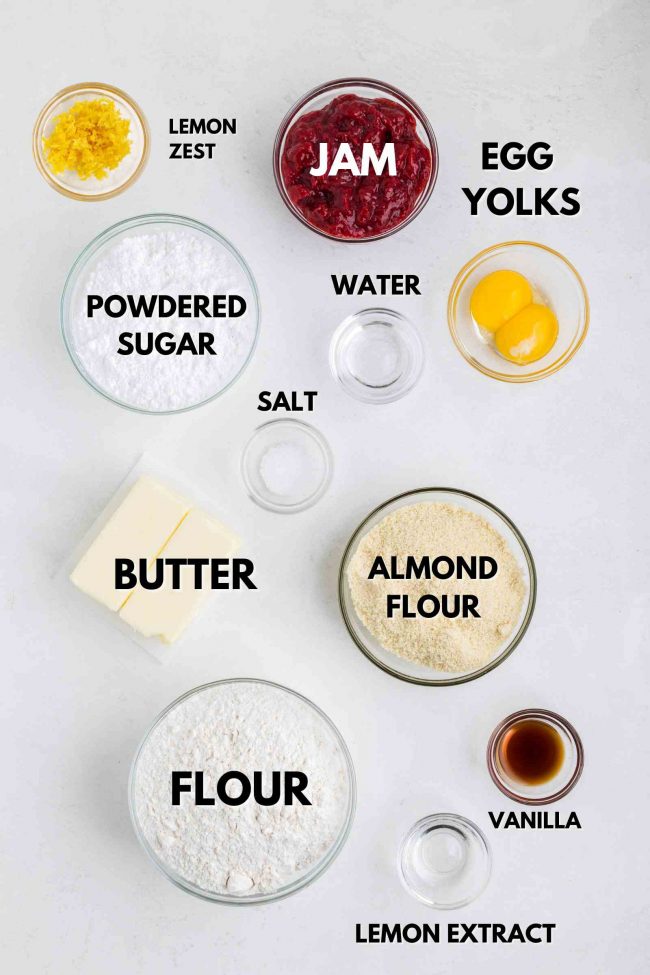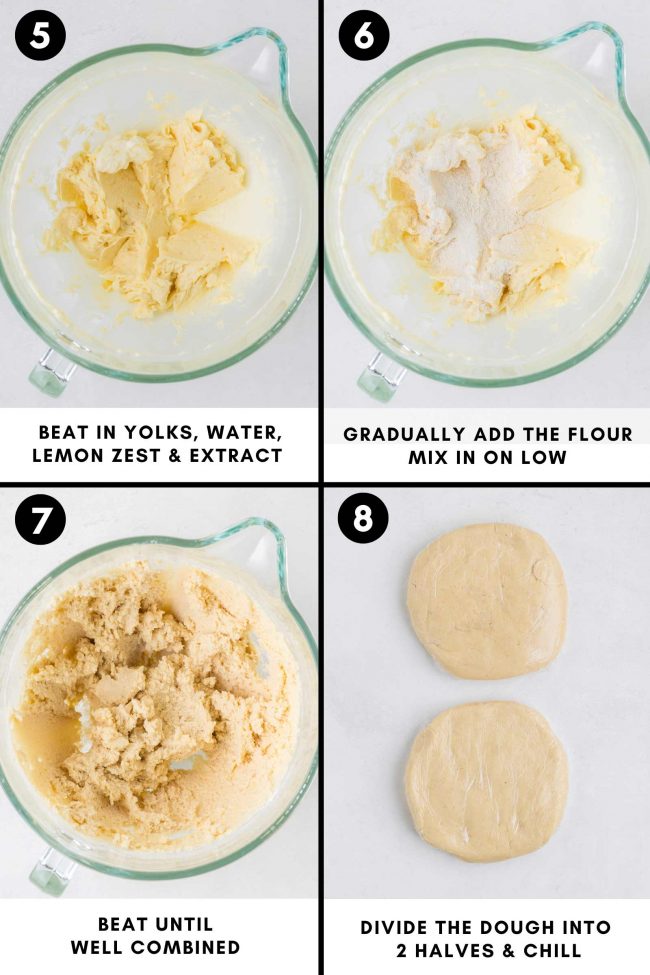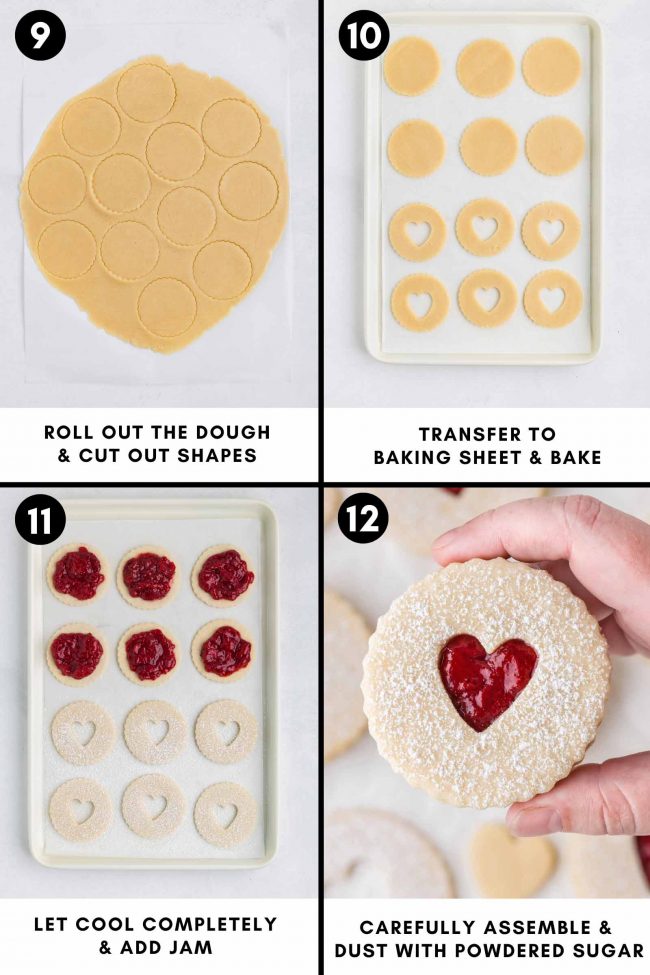These Linzer tart cookies are a classic, buttery treat with a bright, lemony flavor and a delicious jam filling. Whether you choose to make them with regular flour or a gluten-free flour blend, they offer a delightful, melt-in-your-mouth texture – or a chewy texture if you refrigerate them!
These cookies are easy to customize with your favorite jam and cookie cutter shapes, making them a versatile option for Christmas, Valentine’s Day or as a fruity summer cookie.
This is the lemon version of the Austrian Linzer Cookies Recipe I posted recently.
The only difference is the type of extract, added lemon zest and heart shapes instead of Christmas trees. So if you’ve already read the other post, there’s no need to read this one because all the info is the same.

What are Linzer cookies?
Linzer cookies are a smaller, cookie adaptation of the traditional Austrian Linzer torte, one of the oldest recorded cakes in the world. Named after the city of Linz, the torte is known for its buttery almond crust filled with jam and topped with a lattice design.
These cookies distill the essence of the torte into a handheld dessert, featuring two lemon-flavored cookies sandwiched with jam and finished with a dusting of powdered sugar.
Traditionally, Linzer cookies are made with almond flour (or sometimes hazelnut meal, depending on the region) and filled with raspberry or red currant jam. Modern variations, however, often include other flavors like strawberry, apricot, or even chocolate.
Their iconic look comes from the top cookie, which has a cut-out shape that reveals the jam beneath. Popular cut-out shapes include hearts, stars, and circles, adding a festive and elegant touch.
Perfect for holidays, special events, or any time you crave a refined, delicate treat, these cookies may look intricate, but they’re surprisingly easy to make with the right tools and techniques. That said, they do require a fair bit of time.
Some traditional Linzer cookies include spices like cinnamon, nutmeg, or cloves, especially in older or regional recipes. However, many modern versions omit spices to highlight the almond and buttery flavors.
I’ve tried traditional spiced Linzer cookies (living just 50 minutes from Austria!) and personally found them unusual. They’re just not my favorite.

“Lemon extract isn’t traditional!”
You’re absolutely right. Traditional Austrian Linzer cookies don’t use lemon extract or any extract for that matter.
That said, modern versions often include a small amount of extract to enhance the flavor. This tweak is more common in recipes outside of Austria and is largely a matter of personal preference.
If you want to stick to tradition, simply omit the lemon extract. However, I find Linzer cookies a bit bland without it, so I always include it.
Interestingly, vanilla extract isn’t traditional either — but I still use it. 🙈
I’ve shared these cookies with many Germans, and they unanimously preferred the extract version to the no-extract, cinnamon-spiced version.
If you’re aiming for authenticity, substitute 1/2 teaspoon of cinnamon for the extracts and use water instead of lemon or vanilla extract. You can still use the lemon zest, which is traditional, but that much usually isn’t used.
I’m not personally a fan of lemon zest with cinnamon, but everyone is, of course, free to do whatever they like. 🙂

Ingredients
Here’s everything you’ll need to make these cookies.
- Flour – details about the gluten-free option are provided below.
- Almond flour – brings a nutty flavor and tender crumb. More on this ingredient below.
- Unsalted butter – essential for flavor! Coconut oil isn’t a direct substitute, so I don’t recommend using it here.
- Powdered sugar – creates a smooth texture. Don’t use granulated sugar as a replacement.
- Egg yolks – no subs for these.
- Vanilla and lemon extracts – you can use all vanilla if you prefer.
- Preserves or jam – use any flavor you’d like! I went with strawberry, but raspberry is a classic choice.
- Water and salt
I didn’t forget leavening. This recipe doesn’t use any.

As an Amazon Associate, I earn from qualifying purchases. For more info, see my disclosure.
Almond flour vs. almond meal
Almond flour is made from blanched almonds (meaning the skins are removed) that are finely ground into a soft, powdery texture. It’s typically used in recipes that require a smooth, delicate finish, such as macarons, cakes, and Linzer tart cookies.
Almond meal, on the other hand, is made from whole almonds, including the skins. It usually has a speckled appearance due to the almond skins and works best in recipes where texture isn’t as important, like muffins or quick breads.
For recipes like Linzer cookies, almond flour is ideal because its fine texture creates the tender and delicate consistency that these cookies are known for. Using almond meal would result in cookies speckled with almond skin and a less refined texture.
If you’re new to buying almond flour, don’t assume that anything labeled almond flour on the shelf is the right choice.
Bob’s Red Mill recently renamed their almond meal to Super-Fine Natural Almond Flour (formerly called Natural Almond Meal).
What most people call almond flour is now labeled Super-Fine Almond Flour, which is what you need.
NOW Foods sells “Raw Almond Flour,” but it’s actually almond meal. So you don’t want that, either.
For those outside the US or Canada, be cautious, and don’t buy defatted/deoiled almond flour. This type is very finely ground and powdery, similar to the texture of coconut flour, and won’t work the same as blanched finely ground almonds (the equivalent of US almond flour).
What you likely need to buy is called “ground almonds” rather than “almond flour,” which often refers to the deoiled powdery type.
I know this can be confusing. Here’s an example!
In Germany, mandelmehl translates to “almond flour,” but it’s actually defatted almond flour. Using it would make your baked goods, especially these cookies, too dry.
The correct product is blanchierte gemahlene Mandeln, which translates to “blanched ground almonds.”

Can I use homemade almond flour?
Homemade almond flour is typically coarser and not as finely ground as store-bought. The difference in texture is significant.
Using homemade almond flour for this recipe would cause the cookies to spread too much and turn out greasy. The edges would also be lacy and fragile.
While experimenting in other recipes where appearance isn’t a concern might be okay, for these Linzer tart cookies — which need to hold their shape — it’s essential to use finely ground, store-bought blanched almond flour.
How to make them
Making Linzer cookies involves three main stages: preparing the dough, baking the cookies, and assembling them.
Some recipes suggest using just 1/2 teaspoon or 1 teaspoon of jam per cookie, but I found that too skimpy. I opted for 1 1/2 teaspoons per cookie, which worked perfectly for my taste.
Feel free to experiment and find your preferred amount. The recipe provides enough jam for using 1 1/2 teaspoons on 28 cookies.
I’m pasting the text in the collages below for the folks who use text readers.
Stir together flour, almond flour and salt until combined.
Beat the butter and powdered sugar until combined.

Beat in yolks, water, almond extract. Gradually add the flour mix in on low.
Divide the dough into 2 halves and chill.

Roll out the dough and cut out shapes.
Let cool completely and add jam.
Transfer to baking sheet and bake.
Carefully assemble and dust with powdered sugar.

Yield and cookie cutters
The yield will vary depending on the size of your cookie cutters and how thick you roll the dough.
I made 28 assembled Linzer tart cookies using a 2.25″ (5.7 cm) cutter. With a 2.75″ (7 cm) cutter, I got 23 assembled cookies.
Wilton’s Linzer Cookie Cutters are a bit larger, measuring 3″ (7.6 cm). They look lovely, but I find them a bit big for holiday parties, where you’ll have plenty of cookies and other desserts to choose from.
However, you don’t need special Linzer cookie cutters. You can use whatever cookie cutters you already own, as long as you have some small shapes like Christmas trees, stars, hearts, or any design you prefer for the cut-out portion in the middle.

Tips
To ensure your Linzer cookies turn out perfectly, follow these helpful tips.
- Chill the dough for at least 2 hours to make it easier to handle. Do not even try to roll out the dough right after mixing!
- Roll the dough between parchment paper to prevent sticking. You don’t want to add extra flour to the dough, which would affect the texture.
- If the shapes are hard to remove or sticky, place the dough (between two sheets of parchment) on a baking sheet and refrigerate for about 20 minutes or freeze for 5-10 minutes. This will make the dough easier to handle.
- Be gentle when assembling the cookies to avoid breaking them. I may have broken a few when I first made them. Whoops.
Troubleshooting
If you run into problems while making Linzer cookies, here are some solutions to common issues.
- Cookies are too crumbly – add a small amount of water to the dough to help it come together.
- Dough is sticky – chill it for an additional 30 minutes before rolling.
- Cookies spread too much – ensure the dough is properly chilled before baking.
- Jam seeps out – use a thicker jam or reduce the amount of filling.

How to make ahead, store, and freeze
- Dough – wrap the dough discs tightly in plastic wrap, then store them in a Ziploc bag in the fridge for up to 3 days or freeze for up to a month.
- Baked, unassembled cookies – store in an airtight container for up to 5 days. Assemble them with jam closer to serving for the freshest taste. For longer storage, freeze the unassembled cookies with parchment paper between layers and store in an airtight container for up to three months. Defrost at room temperature before filling with jam.
- Assembled cookies – store in an airtight container in the fridge for up to 4 days or freeze for up to 3 months. If freezing, only add powdered sugar once they’ve fully thawed.
While most recipes suggest storing Linzer cookies at room temperature for up to 3 or 5 days, I personally find it odd to leave jam sitting out. I refrigerate mine to be safe.
I’ve left baked jam-filled treats, like these Raspberry Thumbprint Cookies or Berry Bars, at room temperature. But for these Linzer heart cookies, where jam is simply spread on the cookie, I prefer to keep them refrigerated.
Maybe I’m the odd one here, but leaving jam out at room temperature for several days just doesn’t sit well with me.

Can I send these in the mail?
Many people ask this about Christmas cookies, and the answer is a definite no.
First, there’s the jam issue I mentioned above.
Secondly, these cookies are quite fragile unless they’re chilled. At room temperature, they can be crumbly and delicate.
Once chilled, they’re sturdier, and you can easily transport them, but be mindful that stacking them will cause the powdered sugar to get messy.
You can either layer the Linzer cookies on top of other cookies or stack them and add powdered sugar once you arrive at your destination.
If you’re looking for cookies that are sturdier and better suited for mailing, try these Almond Paste Cookies (German almond horns). They stay fresh for weeks and hold up well during shipping.
For something quicker and less hassle, my go-to are these Chocolate Gingerbread Cookies, which are sturdy, easy to make, and loved by everyone. I ended up making 9 batches last Christmas!
That said, Linzer cookies are a fun project if you have the time or want to involve kids in an enjoyable kitchen activity. They’re just not the best choice when you’re in a rush. 🙂

Filling options
For the filling, I (and my photographer) used my Strawberry Preserves Recipe, which we had leftover from a previous batch. It worked perfectly for these cookies!
Traditional options include raspberry or red currant jam, but feel free to experiment with any jam or preserve you like.
Gluten-Free option
These cookies turned out just like the ones in the photos when I used King Arthur Flour Gluten-free Measure for Measure Flour.
Other gluten-free brands may yield cookies that are a bit sandier and more crumbly, so I recommend sticking with this brand if possible.
If you’re experimenting with other gluten-free flours, be sure to use a blend designed as a one-to-one substitute for all-purpose flour. DO NOT use almond, coconut, oat, or other flour that aren’t a direction sub for all-purpose flour.
I hope you’ll enjoy making these Linzer tart cookies! I’d love to hear your thoughts in the comments below. Thanks for reading! 🙂
❀

- Prep Time:
- Cook Time:
- Ready in:
- Yield: 28
Ingredients
- 2 1/2 cups (312 grams) all-purpose flour or for gluten-free, use King Arthur Flour Gluten-free Measure for Measure Flour
- 1 cup (100 grams) finely ground blanched almond flour
- 1/2 teaspoon salt
- 1 cup (225 grams) unsalted butter, room temperature
- 1 cup (120 grams) powdered sugar, plus extra for dusting
- 2 large egg yolks, room temperature
- 1 tablespoon lemon zest
- 2 1/2 teaspoons vanilla extract
- 1 1/2 teaspoons lemon extract
- 1 tablespoon water
- up to 3/4 cup + 2 tablespoons jam or preserves
Directions
- In a large mixing bowl, stir together the flour, almond flour and salt. Set aside.
- In the bowl of a stand mixer fitted with the paddle attachment, beat the butter and powdered sugar at medium speed until well combined.
- Turn the speed down to low and add the egg yolks, vanilla extract, lemon extract and zest and water. Beat on low until combined.
- Gradually add the flour mix in on low and continue beating on low, just until combined.
- Divide the dough into two halves (415 grams each) and wrap each one into a disc.
- Chill for 2 hours or up to 3 days. The dough is easier to work with if you let it chill 8+ hours.
- Preheat the oven to 350 °F (175 °C).
- Line a large cookie sheet with a piece of parchment paper.
- Roll one of the discs out onto a non-floured piece of parchment paper. You can place either plastic wrap (that the piece the disc was rolled in) or parchment paper on top of the dough to create a barrier between the dough and the rolling pin.
- Roll the dough out to be about 1/8” (.3 cm) thick.
- Use a round cookie cutter (mine was 2.25” (5.7 cm)) to cut out solid circles and circles with a cut-out (you want the same number of both). The disc of dough was 415 grams and each set of circle + circle with a cut-out was 29 grams, so with this disc of dough, you should be able to make 14 Linzer cookies (so that’s 14 solid circles + 14 circles with a cut-out).
- If the dough is easy to work with, you can already transfer the circles on the parchment-lined cookie sheet. They only spread a tiny amount so they can be pretty close together. If it’s at all sticky, place the piece of parchment paper and the rolled-out dough onto a baking sheet and place in the fridge for about 20 minutes to firm up again, or place in the freezer for 5-10 minutes. Then transfer to the baking sheet.
- Bake for 7-10 minutes or until the edges have very lightly browned.
- Let cool for about 10 minutes on the cookie sheet, and then transfer the cookies to a cooling rack. Let cool completely, another 20-30 minutes. They can’t be warm at all or the powdered sugar will dissolve.
- Roll out the rest of the dough from the first disc and bake the rest of those cookies. You’ll probably need to chill the dough since it’s been sitting out for a bit.
- Then do the other disc of dough.
- At this point, everyone else dusts the tops of the cut-out cookies with powdered sugar. But then you have to be very, very careful handling the cookies so you don’t mess up the powdered sugar. I tested out dusting the whole assembled cookie with powdered sugar and the powdered sugar immediately dissolved on top of the jam, and you couldn’t see it at all. I suggest experimenting with both methods and seeing which one you prefer.
- Spread about 1 1/2 teaspoons of strawberry preserves into the center of one of the circles. You can do as little as 1/2 teaspoon, if you prefer. You have to be careful with them because they break easily.
- Carefully top with one of the cut-out cookies.
- They’re crumbly at this point, but if you refrigerate them for 8+ hours, the cookies absorb some of the preserves and become chewy. The powdered sugar remained perfect looking.
- Store in an airtight container in the fridge for up to 4 days or freeze for up to 3 months. If you know you’re going to freeze them, add the powered sugar only after defrosting.
Make the dough:
Bake the cookies:
Assemble the cookies:
Notes
- I see other people using 1/2 teaspoon or 1 teaspoon of jam per cookie, but I didn’t like them with so little. So I used 1 1/2 teaspoons. If you make 28 cookies, that means 14 tablespoons of jam. If you only want to use 1 teaspoon, then you’ll need 7 tablespoons.

